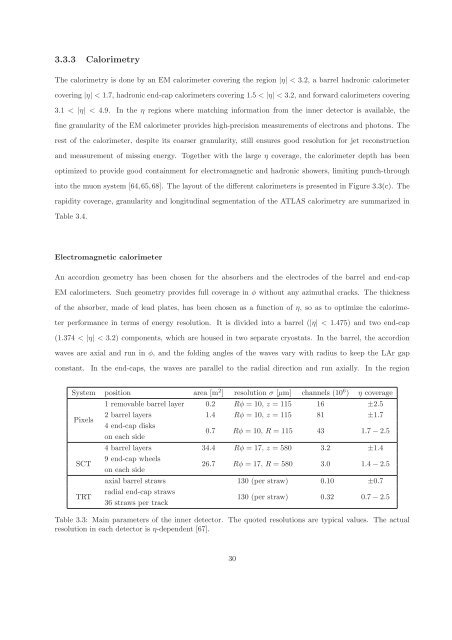CERN-THESIS-2012-153 26/07/2012 - CERN Document Server
CERN-THESIS-2012-153 26/07/2012 - CERN Document Server
CERN-THESIS-2012-153 26/07/2012 - CERN Document Server
Create successful ePaper yourself
Turn your PDF publications into a flip-book with our unique Google optimized e-Paper software.
3.3.3 Calorimetry<br />
The calorimetry is done by an EM calorimeter covering the region |η| < 3.2, a barrel hadronic calorimeter<br />
covering |η| < 1.7, hadronic end-cap calorimeters covering 1.5 < |η| < 3.2, and forward calorimeters covering<br />
3.1 < |η| < 4.9. In the η regions where matching information from the inner detector is available, the<br />
fine granularity of the EM calorimeter provides high-precision measurements of electrons and photons. The<br />
rest of the calorimeter, despite its coarser granularity, still ensures good resolution for jet reconstruction<br />
and measurement of missing energy. Together with the large η coverage, the calorimeter depth has been<br />
optimized to provide good containment for electromagnetic and hadronic showers, limiting punch-through<br />
into the muon system [64,65,68]. The layout of the different calorimeters is presented in Figure 3.3(c). The<br />
rapidity coverage, granularity and longitudinal segmentation of the ATLAS calorimetry are summarized in<br />
Table 3.4.<br />
Electromagnetic calorimeter<br />
An accordion geometry has been chosen for the absorbers and the electrodes of the barrel and end-cap<br />
EM calorimeters. Such geometry provides full coverage in φ without any azimuthal cracks. The thickness<br />
of the absorber, made of lead plates, has been chosen as a function of η, so as to optimize the calorime-<br />
ter performance in terms of energy resolution. It is divided into a barrel (|η| < 1.475) and two end-cap<br />
(1.374 < |η| < 3.2) components, which are housed in two separate cryostats. In the barrel, the accordion<br />
waves are axial and run in φ, and the folding angles of the waves vary with radius to keep the LAr gap<br />
constant. In the end-caps, the waves are parallel to the radial direction and run axially. In the region<br />
System position area [m 2 ] resolution σ [µm] channels (10 6 ) η coverage<br />
Pixels<br />
SCT<br />
TRT<br />
1 removable barrel layer 0.2 Rφ = 10, z = 115 16 ±2.5<br />
2 barrel layers 1.4 Rφ = 10, z = 115 81 ±1.7<br />
4 end-cap disks<br />
0.7 Rφ = 10, R = 115 43 1.7 − 2.5<br />
on each side<br />
4 barrel layers 34.4 Rφ = 17, z = 580 3.2 ±1.4<br />
9 end-cap wheels<br />
<strong>26</strong>.7 Rφ = 17, R = 580 3.0 1.4 − 2.5<br />
on each side<br />
axial barrel straws 130 (per straw) 0.10 ±0.7<br />
radial end-cap straws<br />
130 (per straw) 0.32 0.7 − 2.5<br />
36 straws per track<br />
Table 3.3: Main parameters of the inner detector. The quoted resolutions are typical values. The actual<br />
resolution in each detector is η-dependent [67].<br />
30















